Chapter 5
CARRYING OUT THE SACRIFICE "Laser
Eyes"
~~~continued
|
|
80

Those sacrificed were often seen as small as
children. |
It was not just that, as one commentator put it,
"kids have no constituency to protest; battered
babies don't vote."(31) Parents vote, and if hurting
and killing children had not been essential to our Time
of Sacrifice, the outcry of parents would easily have
stopped the slaughter of the innocents as quickly as it
had stopped the proposed cutback of Social Security
checks. Yet article after article was written during
the winter of 1981-2 on the rise in infant mortality in
areas hardest hit by budget cutbacks and unemployment, on
the over one million additional children on the poverty
rolls, on the six million children who had lost health
coverage because of layoffs of their parents, of the half
million children who had lost health services because of
the closing by the government of 239 community health
centers, of the hundreds of additional children who would
be battered to death because of Reagan's cutback of
almost all of the funds for the highly successful
National Center on Child Abuse and Neglect-in all, over
twenty million children suffering needless pain, hunger
and death with barely a mourner in sight.(32)
|
During those cold winter nights, we all watched television and
saw nightly scenes of children sleeping in the snow under bridges
because their parents had been laid off and scenes of newborn
infants dying on camera because of lack of funding to the
government's program of diet supplement for poor pregnant and
nursing women. Yet we never really felt guilty for the dead and
suffering children who passed before our eyes. "The Reagan
safety net is a myth," reported television commentator Bill
Moyers. "People are dying as the result of these
cuts."(33) Yet we felt nothing. Nor did Reagan. When
attacked by Rep. BoIling for having caused "human
suffering," he retorted: "Look, my program hasn't
resulted in anyone getting thrown out in the snow or
dying."(34) Denial was total. What had happened to the
guilt?
The usual answer to this question is that we avoided guilt
through use of various rationalizations, by saying it was someone
else's fault, not ours, by blaming everything on "the
impersonal forces of the economic system" and so on. Yet
rationalizations as transparent as these would not by themselves
have been enough to still our conscience when incidents happened
which arose to expose them.
| WE WANTED PEOPLE TO BE HUNGRY |
81 |
As one instance, during the Christmas week at the end of 1981,
the government, to show that Reagan was a caring president,
released 30 million pounds of cheese to be given to the hungry
Americans whom they had previously said did not exist. As
millions of people lined up for their five-pound blocks of
cheese, it was uncomfortably obvious to all that the government
had the means to alleviate hunger during the recession by giving
away much of the 2.4 billion pounds of surplus milk, cheese and
butter which it had bought and was storing to hold up dairy
prices. In fact, the government could give away this food at a
cost that turned out to be less than the $1 million a day it cost
to store it. With the gigantic stockpile being added to at the
rate of $6 million a day, it was obvious that handing out only a
tiny portion of our huge growing stockpile of dairy products-a
stockpile which grew by two-thirds during the reces-sion
years-while warehousing the rest at a higher cost and letting it
eventually rot meant we wanted people to be hungry. It was as
transparent an act of cruelty as President Roosevelt's order to
plough baby pigs into the ground during the Great Depression
(again, to hold up farmers' prices) rather than giving them to
hungry Americans to eat. When one Congressman complained that he
could not understand "why food was withheld and destroyed
even as people went hungry," another, who voted to cut back
on the distribution, replied that having to deliberately cause
people to go hungry was "perhaps the greatest paradox that
we face in our country today."(35) Since such moments of
clarity of motive so often revealed the transparency of our
economic rationalizations, the question remains: what happens to
our guilt? Why do we almost never feel any guilt for the death of
innocent people we hurt and kill through political means?
The answer to this question is that we displace our guilt into
criminals. Every period in history when we increase our
sacrificial victims through economic means also shows a parallel
increase in our efforts to punish criminals. Reagan's Time of
Sacrifice was no exception. Even though overall homicide rates
were not increasing during 1981,36 Reagan and the media invented
a ''crime epidemic'' which was purported to be sweeping the
country. Reagan himself led the nation in this group-fantasy. In
the same speeches in which he asked for "more
sacrifices" by the American people, he also decried the new
"American crime epidemic" whereby criminals are
"quite literally getting away with murder."(37)
Language such as this is the only evidence that Reagan ever dimly
recognized that he himself was "quite literally getting away
with murder" in his economic program. Combined with his
claim that "no one was dying" from Reaganomics, his
insistent repetition that "the people of the community are
really suffering" from a crime wave reveals the shift of
guilt from himself-and ourselves-to criminals.
82
If Reagan needed criminals into whom he could dump his own
guilt, it makes sense that at the same time as he was demanding a
"war on crime" he actually was cutting law enforcement
funds. For if crime were really to be reduced, his guilt would
then return back to him. So law enforcement funds had to be
reduced to keep crime high. Only such irrational motives can
explain the public's attitude toward crime, an attitude which
includes an addiction toward and fascination with criminals that
betrays deeply irrational group-fantasy sources. Since punishment
of criminals is the goal of our laws, not reduction of crime,
studies are easily ignored which show that therapy and guidance
are far more effective and less costly than punishment and
incarceration. For instance, during Reagan's term some states
considered new laws mandating ten-year jail terms for people who
kill or maim others while driving when drunk. Yet it would have
been impossible to get any attention for a proposal to give
intensive therapy and guidance to the same people, even though
the cost would be a fraction of the $100,000 per year per person
cost of jail cells and the results far more effective than
punishment by incarceration in assuring that offenders would not
drive while drunk in the future. Yet rather than do something
which might actually reduce crime, we in Reagan's America spent
most of our time on such emotional issues as the restoration of
capital punishment, in order to accomplish our aim of punishing
"the criminal in ourselves."

Reagan was shown pushing the victims of The Time
of Sacrifice over the sacrificial cliff.
|
The more children Reagan sacrificed, the more local
newspapers discovered such group-fantasies as "an
epidemic of child abuse sweeping the city."(38) As
the official jobless rate moved past the 9 percent rate
early in 1982, Wall Street exulted in the new docility of
workers. ''We are thrilled,'' said Peter Grace, chairman
of W. R. Grace & Co. "We've finally turned the
country around."(39) I'm really excited," of W.
J. Sanders, chairman of a Micro Devices, Inc. "We
are unshackling the real talent of this country and
exposing the inept."(40) Some of |
these "inept" included the disabled, an early Reagan
target even though the Social Security disability fund which
supported them had plenty of money in it from workers' disability
contributions.(41) Over 500,000 disability cases were reviewed in
Reagan's first year, and an astounding 45 percent were terminated
on flimsy pretexts, "even though both their doctors and the
Social Security Administration's own physicians agree that the
individuals cannot perform even ordinary day-to-day functions of
living," according to the Los Angeles Times report on the
crackdown.(42) Equally as "inept" were black youths,
whose unemployment rate topped 50 percent, several million people
who had grown too discouraged to look for work, additional
millions who ran out of unemployment benefits - so that, in
Detroit, many unemployed purposely drank heavily or took drugs so
they could enter alcoholic and drug wards which by law had to
house and feed them - and many other helpless or powerless
people, all symbolically "inept" children to be
punished.
Not included as "inept" were the wealthy, who alone
benefited from the three-quarter trillion dollars in tax cuts
(over the first five years), the largest tax giveaway in the
history of any country, "likely to go down in history as the
single most irresponsible fiscal action in modern times,"
according to former Budget Director James Schlesinger.(43) The
result was a predictable record rise in executive salaries (up 12
percent in recession 1981), a rise in sales of Rolls-Royce,
Cadillac and Mercedes cars, a boom in expensive home swimming
pools and record purchase prices for Manhattan co-ops, mostly for
cash.(44) "We've found that the very wealthy are spending
more money than normal," wrote Newsweek, deadpan. U.S. News
put it more bluntly on their cover: "FLAUNTING WEALTH: IT'S
BACK IN STYLE."(45) As Stockman had put it, "The hogs
were really feeding. The greed level, the level of opportunism,
just got out of control."(46)
Yet this was precisely what we wanted to accomplish, to feed
the top while punishing the bottom. Otherwise, there would have
been at least a token fight by the Democrats against Reaganomics.
Instead, as one commentator put it, "In Washington people
remarked on the magical disap-pearance of the Democratic
Party."(47) Initially, Democratic leaders pretended that
their acquiescence was only tactical. "Democrats Have a
Plan: Sit Back, Relax, Enjoy," headlined The New York Times,
citing a "beaming" Speaker of the House Tip O'Neill,
Jr. as saying "I think I'll sit on the sidelines a
while."(48)
Yet he would sit forever if he thought all the pain would turn
the country against Reagan. Everyone agreed that Reagan's image
was enhanced by his sacrificial actions, not tarnished. Puzzled,
most commentators ascribed this not to the efficacy of sacrifice
but to some mysterious quality in Reagan's personality. "It
doesn't much matter what happens," said
84
New York magazine. "The people like Ronald
Reagan."(49) "For the first time in years, Washington
has a president it really likes, one who clearly relishes the
role and is good at it to boot," echoed The Washington
Post's Haynes Johnson.(50) "The president is still riding
high in the polls," said another reporter, "because in
the domestic area Reagan has acted."(51) "Just about
everybody here thinks Reagan can walk on water," conceded a
Republican politician in Indiana.(52) A Democrat in Houston who
had voted for Reagan thought his decisiveness was more important
than anything else; sounding like a woman in love with a man who
beats her up, she told reporters, "He'll either make us or
break us. He is a leader and I got tired of not having a
leader."(53) As another woman from North Carolina told The
Washington Post, even if everyone were worse off because of the
recession, she herself felt "better off mentally."(54)
The media during this period were filled with praise for the
beneficial effects of the punishment. "IN PRAISE OF
RECESSION," hymned William Safire in The New York Times,
adding, "we must not quit when we are winning."(55)

We moved into a "collapse" phase. |
If anything, most political commentators considered
Reagan not cruel enough for the task we gave him to do
for us. "He may be too nice to be president,"
said the nation's foremost expert on the subject, Richard
Nixon.(56) Haynes Johnson agreed: "One word springs
forward to describe him. Nice."(54) Those few who
disagreed were labeled Reds. "They clearly are
militant radicals," TV announcer Gabe Pressman
pronounced as he watched 10,000 very middle-class
demonstrators in New York protest the presentation of the
humanitarian award to Reagan for "courageous
leadership in humanitarian affairs."(58) Nothing, no
note of criticism, no hint of guilt, must be allowed to
deter us from cleansing our nation in our mystical
sacrificial rebirth. After Reagan moved into his third,
or ''collapse,'' phase, overt birth images began to
appear in the media. |
| Reaganomics was pictured as a giant egg, with Reagan
praying for the birth to take place soon. The more the
recession deepened, the more pain and death inflicted on
the sacrificial victims, the more miraculous the rebirth
of America would be. "We are on the verge of a
recovery like nothing ever seen in this country,"
said the Under Secretary of Treasury.(59) Business Week
agreed, shouting from its front cover "HERE COMES
THE RECOVERY!" |

Reagan prayed for our
rebirth via Reaganomics. |
Many Americans even imagined their wishes had come true and
Reagan had already accomplished the rebirth. For instance,
although the government was borrowing a record $16 billion a
month just to meet its bills, pollsters were startled to find two
out of every five Americans thought Reagan had in fact already
balanced the budget as he had promised.(60) As Reagan himself put
it, "There's a spiritual revival going on in this
country." Like all revivalist movements, it was aimed at a
rebirth through the purging of our sinful excesses. Those who
were puzzled by the "triumph of faith over
evidence,"(61) as economist Lester Thurow called the
fantasies that Reaganomics was working, didn't understand how
much Reagan's America was essentially a religious movement
designed to produce an "America Reborn" through
sacrifice.
Of course, sometimes reality intruded. Then Reagan and his
associates would blame business or Wall Street for not producing
the miraculous rebirth. "We gave them more than they ever
dreamed," complained the Republican minority leader, Rep.
Robert Michel, "and you'd think there would be more of a
quid pro quo. 'We have carried through our commitments,"
agreed Secretary of the Treasury Donald Regan. "But where is
the business response? Where are the new research and development
initiatives? Where are the new plants? Where are the expansion
plans?"(62) That business had no conceivable motive to
expand produc-tion when demand had dried up and industrial
utilization had been reduced to 67 percent seemed to escape these
economic experts. They really believed in the miracles produced
by pain. "Reaganomists: Forge Ahead Despite Pain,"
headlined The Miami Herald. 63 In a revealing "Freudian
slip," Reagan told a fund-raising dinner, "Now we are
trying to get unemployment to go up, and I think we're going to
succeed." Senator Pressler agreed: "It would not be a
good idea to saw him off at the legs at this point."(64)
86
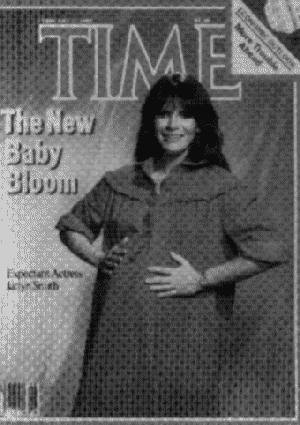
A baby boom was imagined |
During the spring of 1982, images of the rebirth
group-fantasy multiplied in the media, until they
subliminally dominated the feeling-tone of every
American's daily life, though they were not consciously
noticed by most people. A "new baby boom" was
proclaimed, although the actual birth rate per potential
mother was dropping.(65) Pictures of pregnant women were
displayed on the front covers of magazines to show what
was happening. In fact, everything suddenly seemed to be
pregnant that spring, from Reaganomics to the atomic
bomb. Phrases associated with birth feelings began to be
used with increasing frequency, such as "It's like
waiting for a baby to be born"(66) or "the
pressure was building from all sides"(67) or
"This Administration believes that life begins at
conception and ends at birth."(68) |
Discussions of abortion multiplied. Reagan even personally
endorsed a bizarre plan by anti-abortion advocates in California
to hold a fetus funeral for 17,000 aborted fetuses which the
group had collected.(69)
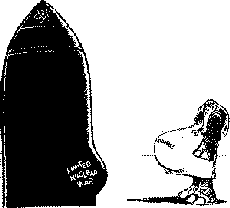
Everything seemed to be pregnant in the spring of
1982. |
New legislation also seemed to be stuck in the birth
canal that spring. The Washington Post cartoonist drew
Reagan as though he were helping Tip O'Neill give birth,
and the caption right next to the cartoon quoted Reagan
as saying, "You may make me crap a pineapple, but
you can't make me crap a cactus," as though Reagan
himself were the one who felt he was giving birth.(70) |
| THAT DARK BIRTH TUNNEL |
87 |
As Reagan told the nation, America would "soon emerge
from this dark tunnel of recession"-the same dark tunnel
which America had hoped to see "the light at the end
of" during the Vietnam war. Everything seemed to be going
down that dark birth tunnel that spring: the White House, the
economy, all of Washington, Reagan himself, the American people.
The world was felt to be one giant hole, and we were

We all felt as if we were going down a dark birth tunnel.
88
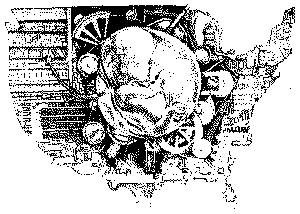
Reindustrialization was seen as a fetus in the
womb. |
dropping into it, as we felt we did long ago during
our own births.(71) Reagan announced in April that we
were "approaching a climactic stage," one in
which he began to hear "a drum beat' '-ostensibly of
criticism, but equally the loud heart beat of the mother
in labor. American revitalization and reindustrialization
were imagined to be the prize at the end of the rebirth
tunnel, and were pictured as a fetus in the womb awaiting
birth.
|
Uncle Sam, too, was pictured as standing in the watery womb,
looking at a drawing of where we were-in the womb-like belly of a
whale, ready to begin our birth travail. It would be terribly
painful, but it was unavoidable, and the sooner we got it over
with the better.
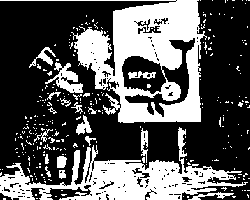
We felt like we were in the womb, awaiting birth. |
With birth beginning, with the pressures building, it
seemed as if "Mother Nature" was "going
berserk," as a U.S. News cover put it. With our
faith in the economy collapsing, as our mother's womb
once did, we imagined birth would feel as if the world
were ending, as it felt during our own births, when the
contraction pressures and hypoxia (lack of oxygen) made
us feel as if we were dying. Therefore, newspapers across
the country began running articles describing fears of
"The End of the World," supposedly in
connection with the chance lining up of the planets which
took place that spring, in about the same manner as the
previous year, when no notice had been taken of it.(72) |
| OUR APOCALYPTIC FANTASIES |
89 |
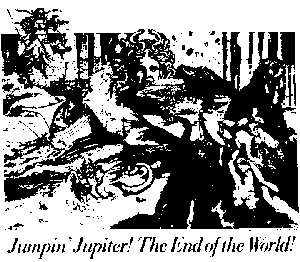
We feared birth would feel like the end of the world.
In fact, our apocalyptic fantasies soon reached such a degree
of reality to us that we became newly concerned with the
possibility of a nuclear holocaust ending the world. Observers
were puzzled at the timing of the new concern over nuclear war.
"Why," asked The New York Times, "37 years into
the Atomic Age, the sudden rush of concern? Has last year's
European peace movement crossed the Atlantic?
| Is it that a new generation has grown up ignorant of
Strangelove? Have older generations failed fully to
appreciate the risks?"(73) Unless one recognized the
birth fantasy, the sudden and all - too - temporary
attention to atomic apocalypse-climaxing in the massive
Freeze rally in New York City on June 12th - was
inexplicable. As did Carter's America during its
"collapse" phase, Reagan's America seemed
everywhere to be full of falling and collapsing feelings,
which could only be cleansed through some apocalyptic
upheaval, some acting out in reality of the powerful
fantasies we shared.
|
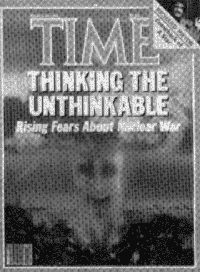
Our apocalyptic fantasies included a renewed
interest in nuclear war. |
90

We seemed to be going off a birth cliff.
We were trapped, unable to be born.
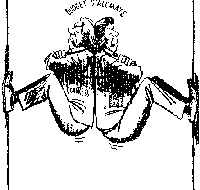
We felt stuck in the birth canal.
|
Yet nothing in reality seemed to be
available to us which we could use to move the birth
fantasy along. No foreign nations threatened, and none
seemed to be forthcoming in the near future to accept our
challenge and deflect our bad feelings outward.
Everything seemed to make us feel trapped in this unborn
position. Our economy was still falling. No miraculous
rebirth could be found there soon. We were unprepared
emotionally to go to war. All seemed increasingly
hopeless. Just as the baby feels its birth pains are
endless, we, too, felt closed in, without hope, unable to
get a breath of relief, stuck in the birth canal forever. This
imagery of being stuck in the birth canal dominated the
country's cartoons that April, and the political language
reflected the fantasy. "Treasury Secretary Donald T.
Regan pronounced the national economy 'dead in the water'
yesterday," the newspapers reported.(74) We were in
fact "in a deep trough," the White House press
secretary confirmed soon after.(75) It seemed as if we
might lie in the womb, "dead in the water,"
forever. How could the birth be pushed along? Where could
we look for help?
The answer to our dilemma came from events even then
moving to a climax in the South Atlantic.
|

We felt "dead in the water."
To report errors in this electronic
transcription please contact:
[email protected]














